Beatles Albums and Why People Collect Them
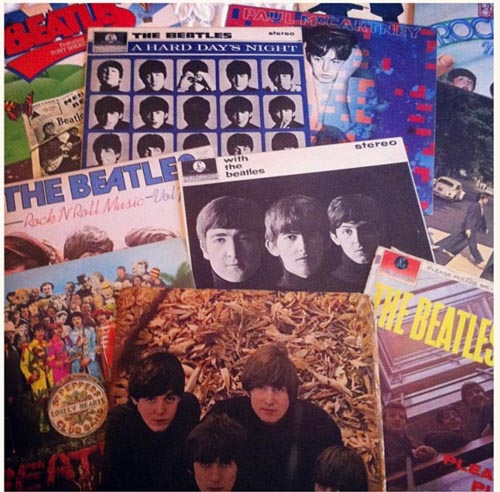 When it comes to record collecting, some artists are more popular with collectors than others. No artist, however, is quite as collectible as the Beatles, though Elvis Presley comes close. Despite being available for more than fifty years and with most of their records never going out of print, Beatles albums draw more interest, and sell for more money, than those by any other artist.
When it comes to record collecting, some artists are more popular with collectors than others. No artist, however, is quite as collectible as the Beatles, though Elvis Presley comes close. Despite being available for more than fifty years and with most of their records never going out of print, Beatles albums draw more interest, and sell for more money, than those by any other artist.
Collector interest in Beatles albums isn’t limited to original pressings, either, though first pressings of their records do command a lot of interest. Later issues, reissues, limited edition items and compilation Beatles albums assembled long after the group broke up in 1970 are also of interest to record collectors.
In this article, we’ll attempt to give an overview of the sorts of Beatles albums that tend to attract the most attention among collectors and we’ll show a few examples of some of the Beatles albums that tend to sell for the most money on the collector market.
Browse by Category
Click any of the links below to jump to each category:
Beatles Albums on Parlophone
Beatles Albums on Vee Jay
Beatles Albums on Other Labels
Beatles Albums on Capitol
Yesterday and Today
Beatles Albums on Apple
Other Foreign Releases of Note
Picture Discs and Colored Vinyl
Bootleg Beatles Albums
Recent Releases
Conclusion
Featured Products
-
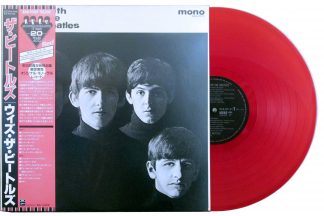
Beatles – With the Beatles limited edition red vinyl Japan mono LP with obi
$175.00Free U.S. shipping! A 1986 mono red vinyl limited edition pressing of With the Beatles by the Beatles, including the original obi.Add to cart -
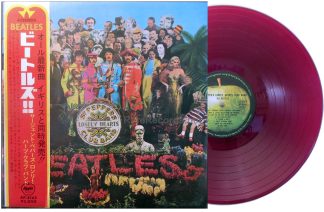
Beatles – Sgt. Pepper Japan red vinyl Apple LP with obi
$295.00Free U.S. shipping! A 1969 Japanese red vinyl pressing of Sgt. Pepper's Lonely Hearts Club Band by the Beatles, including the original obi.Add to cart -
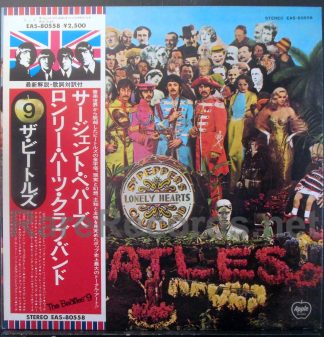
Beatles – Sgt. Pepper Japan Apple white label promotional LP with obi
$250.00Free U.S. shipping! A 1976 Japanese white label promotional pressing of Sgt. Pepper's Lonely Hearts Club Band by the Beatles, including the original obi and cutout insert.Add to cart
Click here to view our selection of Beatles albums.
Beatles Albums on Parlophone
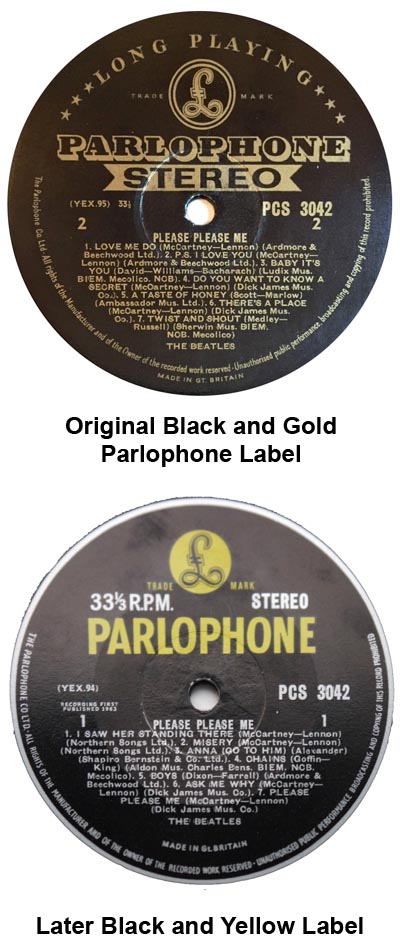 While collectors worldwide are usually the most interested in Beatles albums from the country in which they live, there is also a lot of collector interest in Beatles albums from two countries in particular – Great Britain and the United States. British Beatles albums are of interest because the band hailed from that country, and their records were usually issued in the UK before they were released anywhere else.
While collectors worldwide are usually the most interested in Beatles albums from the country in which they live, there is also a lot of collector interest in Beatles albums from two countries in particular – Great Britain and the United States. British Beatles albums are of interest because the band hailed from that country, and their records were usually issued in the UK before they were released anywhere else.
British Beatles albums also defined what releases should look like and which songs they should contain, making any releases from other countries that differed in any way collectible in their own right.
American Beatles albums are of interest because Capitol Records, the group’s American label, reformatted a number of their albums, changing titles, track listings and artwork, resulting in a number of Beatles albums that were unique to the United States.
Beatles albums issued in Great Britain between 1963 and 1967 were issued on the Parlophone label. The first issues of the band’s debut album, Please Please Me, were issued using label art that dated to the late 1950s, a label known among collectors as the “black and gold” label. This label art was used for only a month or two before being changed to the “black and yellow” label that Parlophone used throughout the remainder of the 1960s, making first issues of Please Please Me quite rare in comparison to later pressings, particularly in stereo.
It has been estimated that perhaps 40,000 or so mono copies of the album were issued on the black and gold label and no more than 900-1000 copies in stereo. As this album was the first album by the Beatles issued anywhere, collectors around the world are interested in acquiring copies of Please Please Me on the black and gold label.
While minor label variations are rampant with Beatles albums, as minor details such as tax codes, the placement of the words “sold in the UK” often appeared in various places on the label or were possibly omitted completely from one pressing to another, the primary interest with collectors lies in obtaining the earliest pressings possible of a given record.
Given that these Beatles albums remained in print for years without obvious changes to the cover or label, how can one know if they’re looking at an early pressing or a later one?
It’s possible to determine whether a particular copy of Beatles albums on Parlophone are early pressings or a later pressing by examining the numbers that are stamped in the area around the record’s label known as the “dead wax” area. These numbers usually indicate the catalog number of the album itself, so that record company employees would know which stampers to use to press a particular record when grabbing them from storage. Those dead wax numbers also indicate, however, roughly how many records of that title had been pressed before it.
Stampers on Parlophone LPs are marked using a stamped letter or series of letters that is generally visible at the 3 o’clock position in the dead wax. A stamper code usually consisted of one, two or three letters, using the table below:
G=1
R=2
A=3
M=4
O=5
P=6
H=7
L=8
T=9
D=0
These letters are derived from the phrase “Gramophone Ltd.” and the letters may appear individually or in combination with others. Each stamper was usually used to press 300-500 discs, and then it was discarded and replaced with a new one. The first 300-500 copies of a given title, for instance, would have the letter “G” stamped in the vinyl at the 3 o’clock position. The next 300-500 copies would use a stamper with the letter “R.” Later pressings might have multiple letters, such as RM, or GRO, which would represent the 24th and 125th stampers, respectively.
As a general rule, Beatles albums with earlier stamper numbers tend to sell for more money among collectors than those with higher stamper numbers, with the emphasis on owning a copy of the album that was pressed as close to the original date of release as possible.
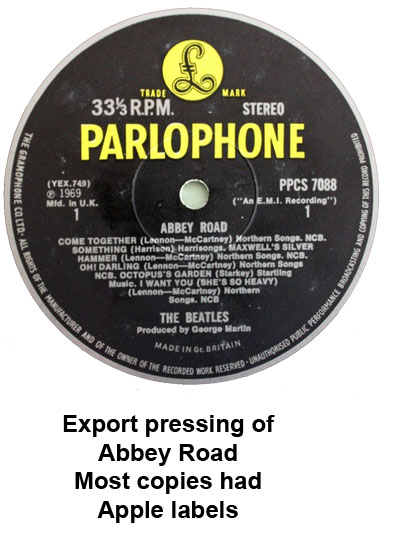 Keep in mind that Beatles albums in Britain were issued in both mono and stereo through 1969 (Yellow Submarine) and that both mono and stereo pressings would have their own sequence of stamper numbers. At the time of the release of Please Please Me in early 1963, mono records outsold their stereo counterparts by a ratio of nearly 100:1, making early stereo pressings quite scarce in comparison with mono copies. This ratio changed through the 1960s, and by 1968, most records sold were in stereo, making mono pressings of later Beatles albums, such as the White Album or Yellow Submarine much harder to find than stereo pressings.
Keep in mind that Beatles albums in Britain were issued in both mono and stereo through 1969 (Yellow Submarine) and that both mono and stereo pressings would have their own sequence of stamper numbers. At the time of the release of Please Please Me in early 1963, mono records outsold their stereo counterparts by a ratio of nearly 100:1, making early stereo pressings quite scarce in comparison with mono copies. This ratio changed through the 1960s, and by 1968, most records sold were in stereo, making mono pressings of later Beatles albums, such as the White Album or Yellow Submarine much harder to find than stereo pressings.
It’s also worth noting that UK Beatles albums are generally harder to find than their American counterparts, as the country is smaller and has fewer buyers. An original American copy of just about any Beatles album will be easier to find than its British equivalent.
Albums issued in Britain by the Beatles, 1963-1967:
- Please Please Me (March 1963)
- With the Beatles (November 1963)
- A Hard Day’s Night (July 1964)
- Beatles for Sale (December 1964)
- Help! (August 1965)
- Rubber Soul (December 1965)
- Revolver (August 1966)
- Sgt. Pepper’s Lonely Hearts Club Band (June 1967)
In addition to the Beatles albums above, which were pressed by Parlophone for sale within the UK, the label also pressed a few Beatles albums that were intended to be exported to other countries. These were all rather limited in production and are quite rare today and are highly sought out by collectors.
- Something New
- The Beatles Second Album
- Beatles VI
The three albums above have the same title, cover art and track listing as the American albums of the same title, but they have Parlophone labels instead of Capitol labels.
- The Beatles (The White Album) – Same as the regular UK pressing, except that the album has Parlophone labels instead of Apple labels.
- Yellow Submarine – This pressing, intended for export to Portugal, has an Odeon label, rather than an Apple label.
- Abbey Road – Same as the regular UK pressing, except that the album has Parlophone labels instead of Apple labels.
- Hey Jude – Same as the regular UK pressing, except that the album has Parlophone labels instead of Apple labels. Issued as an export-only release in 1970; the album was released in 1979 with Apple labels.
- Let It Be – Same as the regular UK pressing, except that the album has Parlophone labels instead of Apple labels.
In addition to the titles above, four different Beatles albums were pressed on colored vinyl in 1978 for export to the United States:
- Magical Mystery Tour – yellow vinyl
- The Beatles (The White Album) – white vinyl
- Abbey Road – green vinyl
- Let It Be – white vinyl
American Beatles Albums on Vee Jay
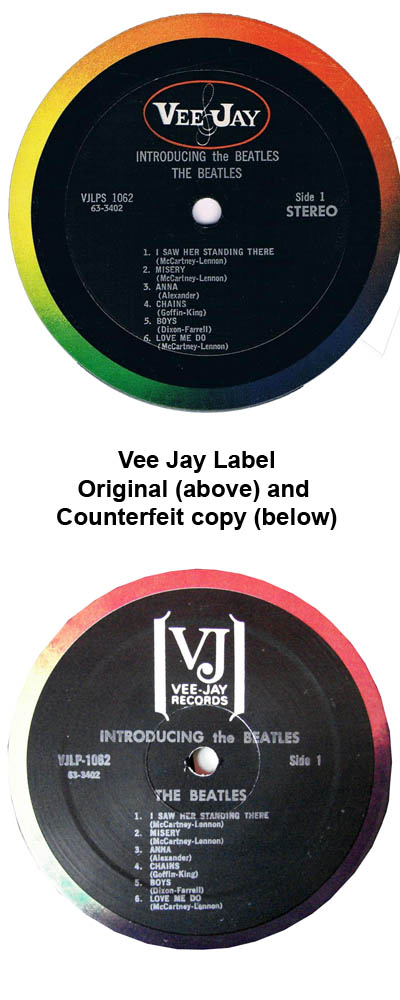 While the history of Beatles albums in the UK is pretty straightforward, with all albums being released on the Parlophone label through 1967 and on the Beatles’ own Apple label thereafter, the story of Beatles albums in the United States is a bit more complex.
While the history of Beatles albums in the UK is pretty straightforward, with all albums being released on the Parlophone label through 1967 and on the Beatles’ own Apple label thereafter, the story of Beatles albums in the United States is a bit more complex.
When the Beatles released their first single, “Love Me Do”, in late 1962, Parlophone’s American counterpart, Capitol Records, passed on the opportunity, as they’d had a poor track record in selling British artists to the American public. A small Chicago-based label, Vee Jay Records, ended up with the rights to the Beatles’ early singles and their first album, which they initially declined to release as the singles by the band they’d released had sold poorly.
In the meantime, the Beatles put together a string of hits in the UK, and Capitol Records took notice. When the cash-strapped Vee Jay neglected to pay royalties on the singles they’d sold, Parlophone assigned the rights to the American market to Capitol, and a series of lawsuits followed. As Capitol prepared to release the Beatles second album (With the Beatles in Britian, and Meet the Beatles in the U.S.), Vee Jay decided to release the Please Please Me album after all, and in early January 1964, two different Beatles albums appeared in stores in America, one on Capitol and one on Vee Jay.
The Vee Jay release of the Please Please Me album was released as Introducing the Beatles and was rushed to market in such a hurry that the first pressings didn’t even have a listing of the songs on the cover. Instead, the back cover of the album simply had photos of other albums by Vee Jay artists.
During the first quarter of 1964, lawyers for the various labels sorted out the matter of whether Vee Jay or Capitol had the rights to the Beatles catalog, and in the end, Vee Jay was given until October, 1964 to stop releasing Beatles product. In addition, they were told that they’d have to remove two songs, “Love Me Do” and “PS I Love You”, from the Introducing the Beatles album.
Tiny Vee Jay was ovewhelmed by demand for their only Beatles album, and they subsequently contracted pressing of the album to multiple companies, which resulted in dozens of pressing and label variations. Some covers listed song titles, others had blank white covers, and some albums were pressed with smaller labels intended for 45 RPM singles when they ran short.
With the October deadline coming up, Vee Jay decided to repackage the limited amount of Beatles material they had in order to increase sales. They repackaged Introducing the Beatles as Songs, Pictures and Stories of the Fabulous Beatles by simply putting discs labeled Introducing the Beatles into new covers. They also combined Introducing the Beatles with the album The Golden Hits of the Four Seasons and sold the two record set as a “battle of the bands” package, titled The Beatles vs. the Four Seasons, complete with a poster and a scorecard on the cover.
 Yet another album combined four Beatles songs that had previously been issued only as singles with a number of songs by singer Frank Ifield and was given the awkward and misleading title of The Beatles and Frank Ifield on Stage, which gave buyers the mistaken impression that the album was recorded live in concert. This album was issued with two different covers, and the second one, which features a drawing of the Beatles (but no Frank Ifield) on the cover, is among the rarest of all Beatles albums.
Yet another album combined four Beatles songs that had previously been issued only as singles with a number of songs by singer Frank Ifield and was given the awkward and misleading title of The Beatles and Frank Ifield on Stage, which gave buyers the mistaken impression that the album was recorded live in concert. This album was issued with two different covers, and the second one, which features a drawing of the Beatles (but no Frank Ifield) on the cover, is among the rarest of all Beatles albums.
Vee Jay also released an album of interviews with the Beatles titled Hear the Beatles Tell All, and this was the one Beatles title that Capitol Records was not able to release themselves, as the album contained no music by the band.
While Beatles albums on Vee Jay sold well in 1964, they were all out of print by October of that year, and many of them were treated poorly by their owners. Because of this, it’s quite difficult to find any Beatles album on Vee Jay in collectible condition today. In addition, Introducing the Beatles has been heavily counterfeited over the years, and may be the most heavily counterfeited record of all time. Most counterfeit copies can be identified by thin vinyl, poor quality printing on the label, and having the name of the band and the title of the album separated by the spindle hole. In addition, most counterfeit copies have stereo covers but have discs that do not say stereo on the label.
As mono albums were more popular than stereo pressings in 1964, Vee Jay pressed approximately 50 mono copies of each title for every stereo copy, making stereo pressings of Introducing the Beatles, Songs Pictures and Stories of the Beatles and The Beatles vs. the Four Seasons much rarer and more expensive today than their mono counterparts.
Beatles albums issued by Vee Jay Records in 1964:
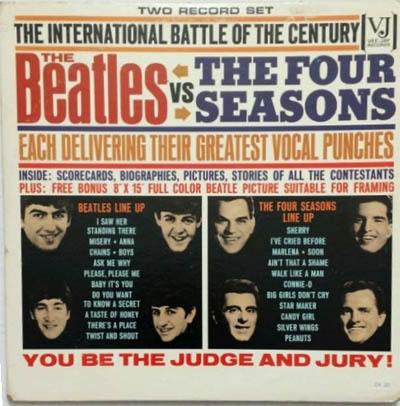 Introducing the Beatles (January 1964) – This was the same album as Please Please Me in the UK, with two songs, Please Please Me, and Ask Me Why, removed to cut the songs from 14 to 12. After a lawsuit, those two songs were added back to the album, and the songs Love Me Do and PS I Love You were removed.
Introducing the Beatles (January 1964) – This was the same album as Please Please Me in the UK, with two songs, Please Please Me, and Ask Me Why, removed to cut the songs from 14 to 12. After a lawsuit, those two songs were added back to the album, and the songs Love Me Do and PS I Love You were removed.- Songs, Pictures and Stories of the Fabulous Beatles (October 1964) – This is the same album as Introducing the Beatles, but with a different cover. The discs inside the cover still say Introducing the Beatles and have that album’s catalog number printed on the label.
- Jolly What! The Beatles and Frank Ifield on Stage (February 1964)– This album contains four Beatles songs and 8 by Australian singer Frank Ifield. Originally issued with a cover showing an old man with a Beatle haircut, the album was later briefly available with a cover showing a drawing of the Beatles and the “Jolly What!” removed from the title. The latter version is among the rarest of all American Beatles albums. The title is quite misleading, as the phrase “on stage” suggests that the album was recorded live. The songs were all studio recordings.
- The Beatles vs. the Four Seasons (2 record set with poster)(October 1964) – This album combined Introducing the Beatles with The Golden Hits of the Four Seasons in a “battle of the bands” concept, which even included a scorecard on the back cover so that buyers could compare the two artists on a song-by-song basis.
- Hear the Beatles Tell All (interview album) – An album of interviews with the Beatles
Beatles Albums on Other Labels
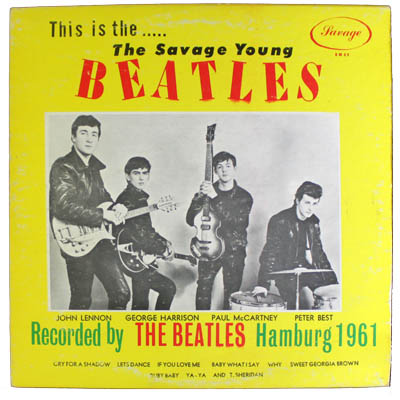 Prior to signing their contract to record for Parlophone in early 1962, the Beatles recorded some songs in Germany as a backup band for British singer Tony Sheridan. These songs, which included “My Bonnie,” with Sheridan on vocals, and “Ain’t She Sweet,” with John Lennon singing, were licensed by a number of record companies that combined those songs with the work of other, largely unknown bands in order to release a “Beatles” album at the height of Beatlemania in 1964.
Prior to signing their contract to record for Parlophone in early 1962, the Beatles recorded some songs in Germany as a backup band for British singer Tony Sheridan. These songs, which included “My Bonnie,” with Sheridan on vocals, and “Ain’t She Sweet,” with John Lennon singing, were licensed by a number of record companies that combined those songs with the work of other, largely unknown bands in order to release a “Beatles” album at the height of Beatlemania in 1964.
Atco Records released an album titled Ain’t She Sweet, combining a few of these songs along with songs by a band called The Swallows. MGM Records used a band called The Titans to fill out an album called The Beatles With Tony Sheridan and Guests. Both of these albums were later reissued on subsidiary labels under different titles. No one ever heard of the Titans or the Swallows again.
Another label called Savage Records released an album called The Savage Young Beatles that contained much of the same material. This album was a bit unusual in that it included a photo of the Beatles on the cover.
Another company called Greatest Records didn’t even bother licensing material; they simply released an album called The Original Greatest Hits, which contained material originally released on Capitol Records.
Greatest attempted to hide this by not mentioning the words “The Beatles” anywhere on the cover, but the drawing of four heads with Beatle haircuts on the cover made it clear exactly what the buyer could expect to hear.
All of these albums are somewhat scarce today and are fairly collectible. They don’t draw the attention of the Parlophone or Capitol releases, but most serious collectors have at least one of the above albums in their collection.
American Beatles Albums on Capitol
 Once Capitol Records secured the rights to release Beatles albums, they began to release them with gusto. The record-buying public had demonstrated that they were willing to buy albums in quantities previously unseen in the music industry, so Capitol set out to give the public as many Beatles albums as they were willing to buy.
Once Capitol Records secured the rights to release Beatles albums, they began to release them with gusto. The record-buying public had demonstrated that they were willing to buy albums in quantities previously unseen in the music industry, so Capitol set out to give the public as many Beatles albums as they were willing to buy.
A couple of differences between the way record albums were sold in the UK vs. the U.S. led to significant differences in album titles and content. In Britain, an album often contained up to 14 songs, while in the United States, albums were typically shorter, having 12 songs instead.
In addition, American albums usually included songs that had been previously released as singles, while albums sold in Britain did not. As Capitol always tried to ensure that the latest album also contained the latest singles, some songs ended up being removed from the albums to make room for the singles. Over time, the removed songs added up and with fewer songs per album and extra songs available from singles, Capitol found themselves with enough Beatles songs to issue a number of albums that were unique to the American market.
Between 1963 and 1966, Parlophone issued seven albums of new Beatles songs. During that same time period, Capitol issued eleven, along with a two-record set of interviews called The Beatles Story.
The Beatles weren’t too happy about this arrangement and when their contract came up for renewal, they insisted that album titles, artwork and content be consistent worldwide. This was the case for all albums from Sgt. Pepper’s Lonely Hearts Club Band in 1967 through Let It Be in 1970.
Albums issued by Capitol, 1964-1967:
- Meet the Beatles (January 1964) – This album had the same cover as Britain’s With the Beatles, but five tracks were dropped and the single I Want to Hold Your Hand and I Saw Her Standing There and This Boy were added.
- The Beatles Second Album (unique U.S. release) (April 1964This album was actually their third American album, and included deleted tracks from Meet the Beatles, the “She Loves You” single with both UK and US b-sides (“I’ll Get You” and “You Can’t Do That”), and two new songs that had previously been released in the UK on an EP – “Long Tall Sally” and “I Call Your Name”
- A Hard Day’s Night (June 1964) – The UK album featured 14 Beatles songs, including 8 from the film of the same name. The U.S. album had a different cover, and mixed 8 songs from the film with four instrumental songs by the George Martin Orchestra that had been used in the movie.
- Something New (unique U.S. release) (July 1964) – This album, unique to the U.S., had 8 songs from the UK A Hard Day’s Night LP, plus “Slow Down” and “Matchbox” from a UK EP release and the German version of “I Want to Hold Your Hand.”
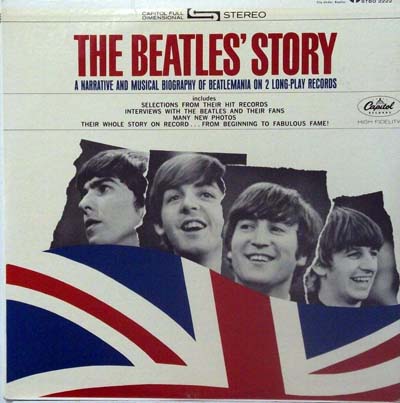 The Beatles Story (unique U.S. release) (November 1964) – This two record set consisted of interviews and portions of press conferences, along with song segments and narration that told the story of the Beatles rise to success.
The Beatles Story (unique U.S. release) (November 1964) – This two record set consisted of interviews and portions of press conferences, along with song segments and narration that told the story of the Beatles rise to success. - Beatles ’65 (unique U.S. release) (December 1964) – This album contained 8 songs from Beatles for Sale, which wasn’t released in America, along with “I’ll Be Back”, “I Feel Fine”, and “She’s a Woman.”
- The Early Beatles (unique U.S. release) (March 1965) – This album contained 11 of the 14 tracks recorded for the Please Please Me LP and was essentially Capitol’s version of Introducing the Beatles.
- Beatles VI (unique U.S. release) (June 1965) – This album included the other 6 songs from Beatles for Sale, two songs recorded just for the U.S. market (“Dizzy Miss Lizzy” and “Bad Boy”), a B-side (“Yes It Is”) and two tracks from the UK Help! Album (“You Like Me Too Much” and “Tell Me What You See.”)
- Help! (August 1965) – Like A Hard Day’s Night before it, Help! was released as a 14 track Beatles album in Britain but in the states it had 7 Beatles songs and five instrumental orchestral pieces from the film. The U.S. release had a unique cover that differed from the UK version.
- Rubber Soul (December 1965) – The U.S. version dropped four songs from the UK album of the same name and added two songs from the UK Help! LP – “I’ve Just Seen a Face” and “It’s Only Love.”
- Yesterday and Today (unique U.S. release) (June 1966) – A hodgepodge of tracks from various sources, including songs from the UK Help!, Rubber Soul and the then-unreleased Revolver LP, plus both sides of the “Day Tripper” single. See more about this LP below.
- Revolver (different tracks from UK LP) (August 1966) – The U.S. album removed three songs from the UK LP, as these had already been issued on Yesterday and Today a few months earlier.
- Sgt. Pepper’s Lonely Hearts Club Band (June 1967) – Same as the UK LP
- Magical Mystery Tour (unique U.S. release) (November 1967) – Tracks from the film of the same name were issued as a double 7” EP set in Britain, but the EP format did not sell well in the U.S. market, so the tracks were combined with songs from three singles issued that year to form a complete album.
All albums from Meet the Beatles through Magical Mystery Tour were issued in both stereo and mono; mono pressings of Sgt. Pepper’s Lonely Hearts Club Band and Magical Mystery Tour are relatively rare, as most buyers were purchasing stereo copies at the time of those albums’ release.
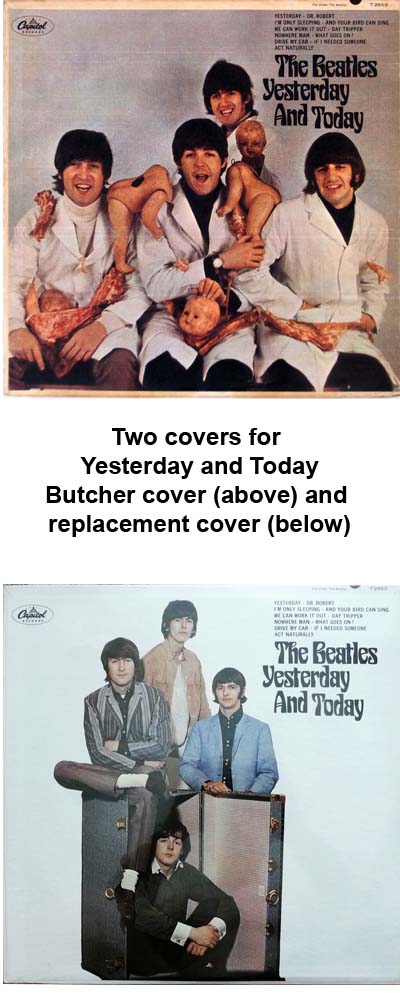 The 1966 album, Yesterday and Today, was a unique release in the Beatles catalog as well as a unique headache for Capitol Records and it became the only Beatles albums to actually lose money on its initial release, despite the fact that it reached #1 on the album charts.
The 1966 album, Yesterday and Today, was a unique release in the Beatles catalog as well as a unique headache for Capitol Records and it became the only Beatles albums to actually lose money on its initial release, despite the fact that it reached #1 on the album charts.
Yesterday and Today, issued in June 1966, was a collection of tracks from three different UK albums, plus both sides of the “Day Tripper” single. As the album was unique to the American market, Capitol needed artwork for it and contacted the band’s management. The photo they received was an usual image of the members of the band wearing butcher smocks while sitting on a bench. Scattered about were heads and bodies from toy dolls and pieces of raw meat.
Promotional copies of the album were sent out to the media and radio and the reaction to the cover photo was hostile. So hostile, in fact, that Capitol made the decision to change the cover to a photo of the band sitting around a steamer trunk. The album had been printed at three different pressing plants, and while the plant in Jacksonville, Illinois destroyed all of their copies of the so-called “Butcher cover” in order to print new ones, the plants in Scranton, Pennsylvania and Los Angeles opted to paste the new cover over the existing ones in order to save time and money.
Very few of the original, “first state” covers survived and only a handful were known to have been sold at retail when the album finally hit the stores. The covers that most buyers saw on the album’s day of release were either new covers printed in Illinois or “pasteover” covers from the other two plants. A few enterprising individuals discovered that it was possible, using steam or chemicals, to remove the second cover to reveal the Butcher cover underneath.
The cost to Capitol to fix the cover problem was reportedly more than $250,000, which equates to nearly $2 million today.
Original “first state” pressings of Yesterday and Today with the Butcher cover photo are quite rare, and sealed copies have sold for as much as $75,000 on the collector market. “Second state” copies, with the trunk cover still attached sell for anywhere from a few hundred dollars to $10,000 or so, depending on condition. “Third state” issues, which are copies that have had the trunk cover removed, can sell for as little as $50 to as much as $3500, depending on the condition of the cover and the degree of success in removing the trunk cover without damaging the image underneath.
The Butcher cover is perhaps the single most sought after of all Beatles albums, and demand remains strong today, despite the fact that they aren’t all that rare. Capitol probably shipped several hundred thousand copies when the album was new, but over time, many of them have been lost or damaged.
We have written a comprehensive article about the Beatles Butcher cover. You can read it here. (opens in a new window)
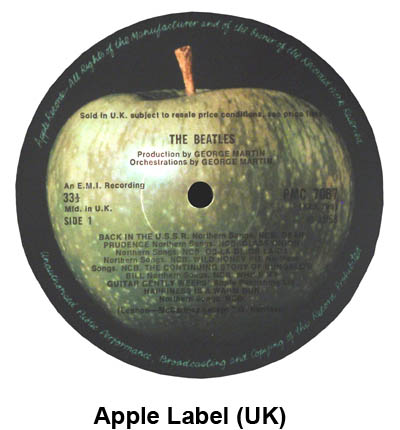 In 1968, the Beatles created their own record label, Apple Records, to be used for their own releases as well as those by other artists signed to the label. Beatles albums released on the Apple label were pressed by Parlophone in Britain and by Capitol in the United States and were identical in title, cover art, and content.
In 1968, the Beatles created their own record label, Apple Records, to be used for their own releases as well as those by other artists signed to the label. Beatles albums released on the Apple label were pressed by Parlophone in Britain and by Capitol in the United States and were identical in title, cover art, and content.
Titles issued on Apple, 1968-1970
- The Beatles (aka “The White Album”) (November 1968) – Issued in a plain white cover; original UK issues had covers that opened at the top, rather than the side. Each copy of the original pressing had a unique number stamped on the front cover. The two record set included four 8”x10” photos and a large poster. Issued in the UK in stereo and mono; in the U.S. in stereo only.
- Yellow Submarine (January 1969) – Soundtrack album; issued in mono and stereo in the UK but U.S. releases were all stereo.
- Abbey Road (September 1969) – Issued only in stereo in both the UK and U.S.
- Hey Jude (February 1970) – A compilation of singles and B-sides that had not previously been issued in album form. The LP was issued in the U.S. in 1970, but not released in the UK until 1979.
- Let It Be (May 1970) – First issues in the UK came in a box that included a large book containing photos from the film of the same name. U.S. issues did not include the book or the box.
The Beatles (White Album) and Yellow Submarine, unlike the UK issues, were released in the United States only in stereo, as sales of mono records in the U.S. had decline to the point where Capitol records was no longer pressing them.
Other Foreign Releases of Note
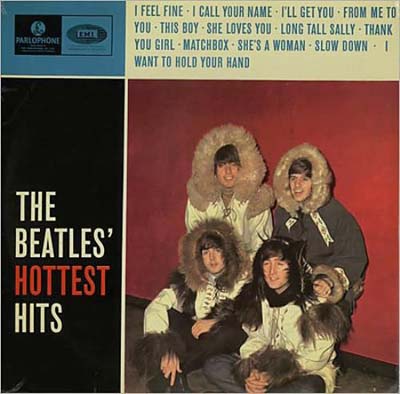 Beatles albums issued in the 1960s in other countries generally followed the UK format, though a few albums issued in Canada, such as Yesterday and Today, followed the U.S. format. In Japan, Beatles albums were issued in both configurations.
Beatles albums issued in the 1960s in other countries generally followed the UK format, though a few albums issued in Canada, such as Yesterday and Today, followed the U.S. format. In Japan, Beatles albums were issued in both configurations.
Japanese Beatles albums of the 1960s were initially pressed on red “Everclean” vinyl, which was specially formulated to minimize static electricity. Later issues were pressed on standard black vinyl. While the red vinyl pressings were not intended to be collector’s items, they have become so over time, and red vinyl copies of Beatles albums from Japan always sell for more money than their black vinyl counterparts. Also of interest on Japanese Beatles albums is the paper sash, or “obi” that was originally attached to the cover. The presence (or absence) of the obi can greatly affect the selling price.
A few other foreign albums tend to attract attention from collectors, including a compilation album from Denmark that shows the Beatles wearing parkas and another from France that shows them riding horses.
Picture Discs and Colored Vinyl
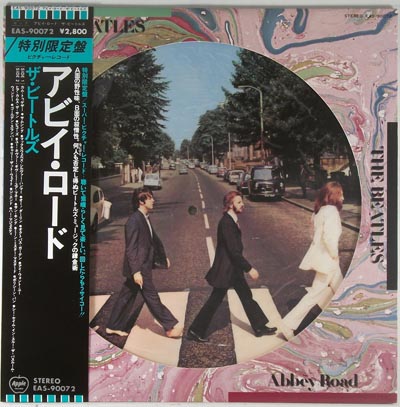 In the 1960s, the original Beatles albums from Japan, which were pressed on red vinyl, were the only albums by the band issued anywhere in the world using a color of vinyl other than black. In the late 1970s, record companies began issuing albums by a variety of artists on colored vinyl as limited edition items. These included a number of titles by the Beatles.
In the 1960s, the original Beatles albums from Japan, which were pressed on red vinyl, were the only albums by the band issued anywhere in the world using a color of vinyl other than black. In the late 1970s, record companies began issuing albums by a variety of artists on colored vinyl as limited edition items. These included a number of titles by the Beatles.
In the United States, Capitol Records released the following Beatles albums on colored vinyl in 1978:
- The Beatles 1962-1966 – red vinyl
- The Beatles 1967-1970 – blue vinyl
- The Beatles (The White Album) – white vinyl
In the UK, four titles were released in 1978 on colored vinyl – Magical Mystery Tour (yellow), The Beatles (The White Album – white), Abbey Road (green) and Let It Be (white.)
In Canada, there were two colored vinyl Beatles albums issued:
- Sgt. Pepper’s Lonely Hearts Club Band – gray marbled vinyl
- Love Songs – yellow vinyl
In France, the following Beatles albums were issued on colored vinyl:
- Sgt. Pepper’s Lonely Hearts Club Band – clear, green, yellow, blue, purple, orange
- The Beatles 1962-1966 – red vinyl
- The Beatles 1967-1970 – blue vinyl
- The Beatles (The White Album) – white vinyl
In Japan, the following Beatles albums were released on colored vinyl:
- The Beatles 1962-1966 – red vinyl
- The Beatles 1967-1970 – blue vinyl
In the Netherlands, the Beatles Greatest Hits was released on both gold and purple vinyl.
The Beatles (The White Album) was released on white vinyl in Germany.
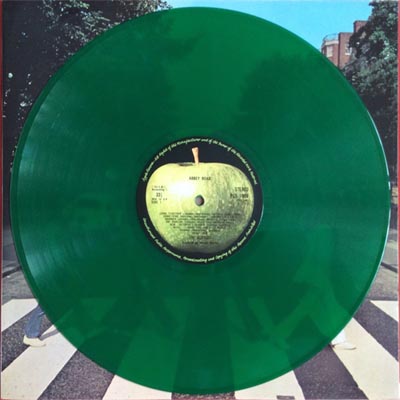 In addition to the colored vinyl albums listed above, a few experimental pressings of Beatles albums have turned up on colored vinyl over the years. These were experimental pressings that were not intended for commercial sale:
In addition to the colored vinyl albums listed above, a few experimental pressings of Beatles albums have turned up on colored vinyl over the years. These were experimental pressings that were not intended for commercial sale:
- Beatles VI – clear vinyl
- Love Songs – brown swirl vinyl/clear vinyl (one disc each)
- The Beatles (The White Album) – clear vinyl, gray and white swirl vinyl, red and white swirl vinyl (one disc only)
- The Beatles 1967-1970 – clear vinyl (one disc only)
About the same time as the colored vinyl releases, Capitol Records issued two different Beatles albums as limited edition picture discs:
- Sgt. Pepper’s Lonely Hearts Club Band
- Abbey Road
These were released in die-cut covers that allowed buyers to see the record, which had the artwork from the cover pressed into the vinyl itself.
The two titles above were also issued as picture discs in Japan. Abbey Road was issued as a picture disc in Holland, with a different cover and artwork from the U.S. or Japanese issues. Sgt. Pepper’s Lonely Hearts Club Band was issued as a picture disc in Germany, with a different cover from the U.S. or Japanese issue.
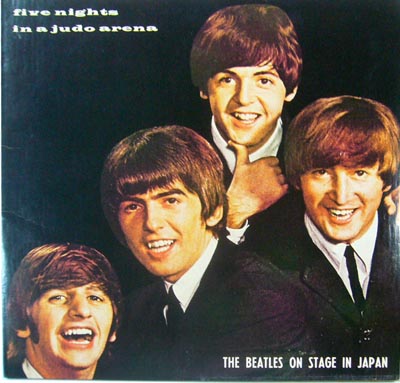 In addition to the authorized releases issued worldwide by Capitol, Parlophone, and Apple, a number of unauthorized, or “bootleg” Beatles albums have been issued by unknown parties over the years.
In addition to the authorized releases issued worldwide by Capitol, Parlophone, and Apple, a number of unauthorized, or “bootleg” Beatles albums have been issued by unknown parties over the years.
The first of these appeared in 1969 or so, and were recordings of the then-unreleased Let It Be material. Other titles soon followed, initially in plain white covers with rubber-stamped titles on them. Later issues became more elaborate, with either paper title inserts attached to the cover or properly printed covers.
At the time, U.S. copyright law was vague, and many of these bootleg Beatles albums were sold in regular record stores and even in department stores. By the mid-1970s, Congress changed the laws to make such unauthorized pressings illegal.
A few titles, including those issued by the famous bootleg label Trademark of Quality, were released on colored vinyl. The content of these bootleg Beatles albums usually fell into two groups – live recordings from 1964-1966 and previously unreleased material. As no authorized live album by the band was available until 1977, bootleg Beatles albums of live material were quite popular in the early 1970s.
One popular title, a recording of the Beatles performing in Japan in 1966, was titled Five Nights in a Judo Arena.
 Most of the unreleased studio material was of very poor quality, as they were usually made from copies of copies of copies of tapes that had been passed around among collectors. In the late 1980s, a series of bootleg albums issued under the title of Ultra Rare Trax became available and offered exceptional sound quality recordings of several hours of previously unreleased material. The quality of this material was so good that it eventually led to the release of the three-volume Anthology series in the mid-1990s.
Most of the unreleased studio material was of very poor quality, as they were usually made from copies of copies of copies of tapes that had been passed around among collectors. In the late 1980s, a series of bootleg albums issued under the title of Ultra Rare Trax became available and offered exceptional sound quality recordings of several hours of previously unreleased material. The quality of this material was so good that it eventually led to the release of the three-volume Anthology series in the mid-1990s.
A few bootleg Beatles albums even included material that wasn’t recorded by the Beatles at all, such as the frequently-included track “Peace of Mind” (also known as “The Candle Burns”), whose source remains unknown, and “Have You Heard the Word”, which was actually a single by a group called The Fut. Another track that often appeared on bootleg Beatles albums was “The L.S. Bumble Bee,” which was actually a track by comedians Peter Cook and Dudley Moore that sounded nothing at all like the work of the Beatles.
Early Beatles bootlegs, particularly those on colored vinyl or those pressed as picture discs, remain popular with collectors. Bootleg picture discs include material from the Let It Be sessions and the band’s 1962 audition recordings for Decca.
Even though the Beatles broke up in 1970, both Capitol and Parlophone continue to release new albums every few years. These have mostly been compilation albums, starting with the 1962-1966 and 1967-1970 sets released in 1973.
Later titles included Love Songs and Rock ‘n Roll Music, which collected ballads and rockers, respectively. An album called Rarities was released in 1980 that included songs that were previously unavailable in LP format.
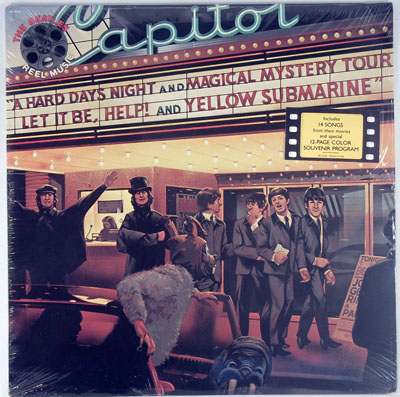 In 1982, Capitol released Reel Music, an album of songs from the Beatles films. In 1995 and 1996, three albums entitled Anthology 1, 2, and 3 were released, and these contained material that was previously only available on bootlegs.
In 1982, Capitol released Reel Music, an album of songs from the Beatles films. In 1995 and 1996, three albums entitled Anthology 1, 2, and 3 were released, and these contained material that was previously only available on bootlegs.
Newer releases have included high-quality box sets containing all of their UK albums in stereo and a separate box set containing mono pressings of all of their albums that were originally released in that format.
All of these albums have sold well, often to buyers who weren’t even born when the band broke up.
Beatles Albums Conclusion
More than 40 years after the Beatles stopped working as a band, collector interest in their albums remains high. Prices for rare and hard to find items continue to climb, with particular emphasis on the Yesterday and Today Butcher cover and the first pressing of the UK Please Please Me LP on the original black and gold label.
For newer collectors, there are lots of moderately priced items on the market, and one can still put together a good sized collection of Beatles albums without having to spend tens of thousands of dollars.
And why not? The Beatles made a lot of great music, and collecting Beatles albums is fun.
Click here to view our selection of Beatles albums.
Share this:











